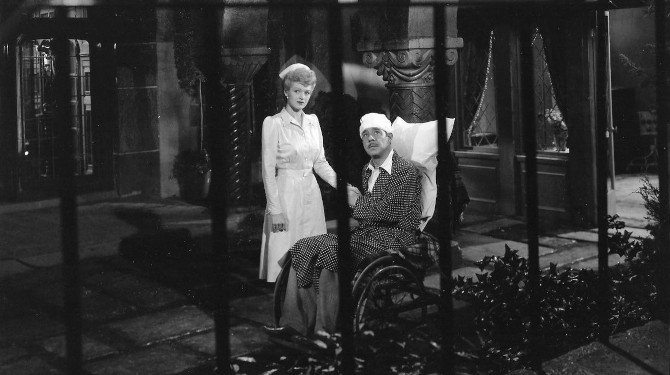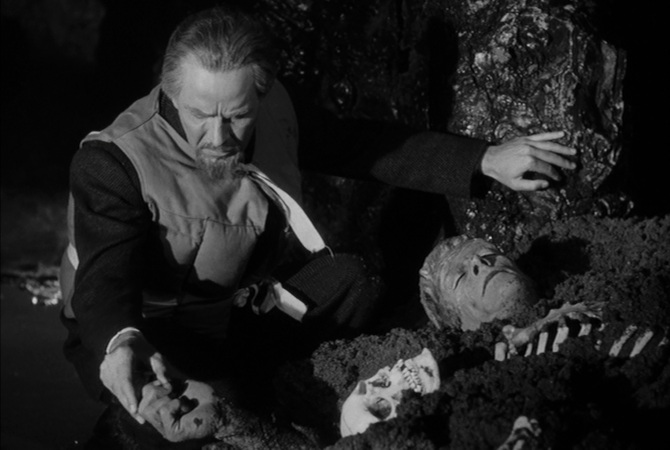Celebrating its 75th anniversary this year (2020), 1945’s House of Dracula, directed by Earl C. Kenton – Island of Lost Souls), is, in many ways, the last of the classic Universal monster movies. Although Abbott and Costello Meet Frankenstein and the three Creature from the Black Lagoon features would follow, this would be the final horror specific film that would centre upon their three most iconic monsters – Dracula, Frankenstein, and the Wolf Man (I apologize in advance for slighting the Invisible Man).
Despite its slightly misleading title, all of the horror hijinks actually take place in and around the gothic castle of Dr. Franz Edlemann (Onslow Stevens), a surprisingly athletic older man (in reality, 43 years old) renowned for his dynamic and forward thinking form of medicine. Drawing the attention of Count Dracula (John Carradine), hiding behind the moniker of Baron Latos, and the perhaps more tortured than ever before Lawrence Talbot, a.k.a. the Wolf Man (Lon Chaney Jr. – the only actor to play the same monster every single time he appeared onscreen for Universal) – this time porting a mustache, both have sought him out – seemingly looking for a cure to their respective torturous affliction. Talk about quite the situation. . . Dracula moves into the basement, while Wolf Man takes residence in one of the upstairs bedrooms – not so sure if this a remedy for a good night’s sleep!
With the help of his nurses, Miliza Morelle (Martha O’Driscoll), who has an unexpectedly long history with the Count, and the prettiest hunchback you’ll ever see, Nina (Jane Adams), Dr. Edlemann has long been investigating the spores of the clavaria formosa, which has a property that seems to have impressive healing powers.
A less expected arrival is the Frankenstein Monster (Glenn Strange – his second of three times donning the bolts and boots), a discovery that piques the curiosity of the eccentric doctor. Found in the quagmire deep within the caverns underneath the castle (a scene that found the actor in freezing liquid mud – that doubled as the quicksand – Chaney, a known alcoholic, continuously passed whiskey to Strange to warm him up. . . so drunk at the end of work, he could barely dress himself), the undying creature is basically lifeless.
With a roster of patients that could only be described as an all-time all-star team, it is not surprising that some bizarre occurrences begin to happen in and around the historic structure, drawing the calm eye of small town Police Inspector Holtz (Lionel Atwill – who sadly passed away from cancer just five months after the film’s release).
A playful, spoof-easy send-off to the classic Universal monsters, this roster of iconic actors are in fine form. . . relishing the roles they find themselves in – Carradine oozing the depraved, seductive if snooty aristocratic form of a wealthy, several centuries old man; Chaney adding continuity as the same old tortured, near-suicidal soul looking desperately for just one good break; while, with Frankenstein, we get the best of all worlds (Strange in the present, while flashbacks and some reusable footage feature the equally majestic, and even more lauded performances of both Boris Karloff and Lon Chaney Jr. . . . knowledgeable movie buffs will also spot Eddie Parker – Chaney’s stunt double in the role); while the lesser known Stevens is an absolute smash as the doctor (who slowly becomes more and more Hyde-like the longer the production goes). Lastly, I’d also like to highlight a highly effective supporting performance from a riotous villager named Steinmuhl (Skelton Knaggs), a creepy man who looks like the Nazi from Raiders of the Lost Ark after he has melted.
Backed by the striking hard lighting (of the low lit sets) found in these early monster movies (this time from Universal regular George Robinson – a man who did so many of these horror films as well as many of the Abbott and Costello movies), every backdrop is a piece of art – shadowy figures prowl, electrical instruments flash and bang, candlelight flickers, lanterns highlight. . . this black and white background is fantastically realized (hiding the fact this one was made on the cheap).
At a breezy sixty-seven minutes, House of Dracula is the horror version of an Avengers-style film of its day. Both playing with, and stealing from the previous Universal pictures that came before it (and soon to be spoofed a few years later by Abbott and Costello), it is an absolute pleasure for horror fans to pick through this speedy picture. Though by no means a fantastic film, it is competently directed, features those aforementioned stellar performances, eye-popping cinematography, and is, despite its lack of scariness, a whole lot of playful fun. . . plus, you can’t beat these oft semi-recycled scores (this time by William Lava). So, cure what’s ailing you by seeing this seventy-five year old horror classic, after all, this one shouldn’t draw too much fire.




